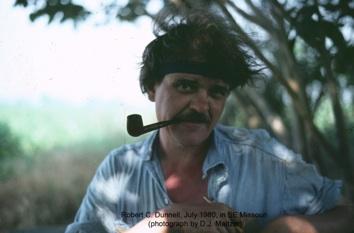By James Feathers
Research Associate Professor
Director, Luminescence Dating Laboratory
PhD 1990, Dunnell advisee
Robert C. Dunnell, 68, former department chair and a renowned leader in American archaeology, died December 13, 2010 of congestive heart failure near his home in Natchez, Mississippi, after several years of illness.
Dr. Dunnell started in archaeology as a teenager growing up in West Virginia, his work even appearing in a local newspaper at age fourteen. He graduated from the University of Kentucky in 1964 and then received his PhD from Yale in 1967. He joined the UW faculty that same year, serving as chair from 1972 to 1985, and retired in December of 1997. A total of 29 students received their PhDs under his mentorship.
He is best known for his theoretical contributions to archaeology both in systematics and explanatory theory. These subjects were embodied in two courses, ARCHY 497 and ARCHY 498, which were requirements for every archaeology graduate student who came through the program during his tenure. In many cases, these courses were life-changing experiences for the students.
Systematics, the study of classification and unit formation, was the subject of Dr. Dunnell’s early book, Systematics in Prehistory (1971), which lay a foundation for studying the archaeological record in a scientific fashion. His advocacy for making archaeology a science led to detailed critiques of past and contemporary archaeological practices. Although these did not win him many friends, those who embraced his ideas often found that his clarity in these matters opened expansive possibilities for new knowledge gained from an empirical study of artifacts. His work on the theoretical underpinnings of seriation and its use, not only for dating but also for understanding social structure, is a good example.
His interest in explanatory theory originated in part from a dissatisfaction with traditional understandings of the prehistory of the Eastern United States, his main substantive interest. A long-term goal of his was to write a definitive prehistory of the East. Although this goal eluded him, it led him to search for an appropriate explanatory framework, which he found in Darwinian evolutionary theory. Much of his professional life was devoted to identifying how this framework could be adapted to the archaeological record, which reveals cultural traits transmitted through time and space via learning and not genetics. His pioneering work has led to increased popularity in evolutionary approaches to archaeology in recent years. For example, references to the bet-hedging concept for understanding monumental architecture and other cultural elaborations, a concept that stems from Dr. Dunnell’s attempt to understand Hopewell elaborations as energetic “waste,” are appearing more and more in the literature.
His contributions were broader than in just theoretical archaeology. His interests extended to methodology of fieldwork and laboratory analysis. Almost all of his students at one time or another spent a 100°F+ summer with him in Southeast Missouri, doing survey and surface collection from plowed fields. He always maintained that one hour in the field translated into ten hours in the lab. Full understanding of artifacts requires knowledge of their physics and chemistry, and this led him to embrace the field of archaeometry. Among his achievements in this area was the founding of the Luminescence Dating Laboratory in the department in 1983, a laboratory I am happy to report is still going strong after nearly 30 years.
Dr. Dunnell’s cantankerous and sometimes awkward demeanor was well-known. It was also widely misinterpreted, and often made him appear less than diplomatic. He held clear and strong conceptual differences with colleagues on how science should be done—or whether science should be done at all. Politically, he was far more conservative than most of his fellow academicians, but he never forced his political views onto his students. And of course his standards were demanding; he cared deeply about teaching his students how to think, a point made succinctly and humorously in a recent blog by former UW student Tony Cagle, which should be read by anyone interested in how it was to be a student under his tutelage. In the end, most of his students discovered that if they demonstrated a seriousness about studying archaeology they had a collaborator and friend for life. He will be missed sorely by all of us.
He is survived by his wife Mary, his life-long partner whom he fondly referred to as “the beast.” The clarity in his writing owes much to the painstaking editing she did on almost all of his manuscripts.
